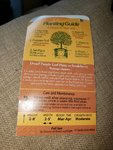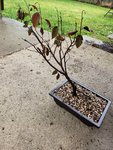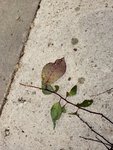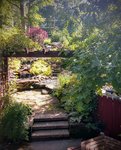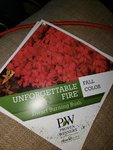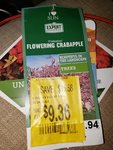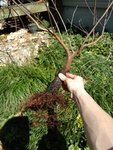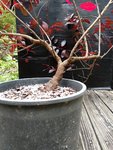I guess technically it's both

Really? The tree out front is nothing like the one in the backyard as a shrub. That's peculiar...or, is the tag stating both species?
I'm going to wander down a relatively unimportant side road.
Botanically speaking, the genus Prunus includes: cherries, plums, apricots, peaches, nectarines, almonds, sloe, & ume, & half a dozen others that have names that don't fall in the other categories. In the genus Prunus, there are some 430 species, give or take 50 or so. There is no bright line that separate cherries from plums. There are species that have traits of either or both groups, and the common names are really vague when it comes to botanical traits. Prunus are often called the stone fruit as the seeds have very hard shells. Cherries tend to have round "pits", hard shelled seed that are nearly round, but not all cherries are perfectly round seed. Plums have smooth skin fruit, with flattened oval seed, with rough but not fissured seed coat. Apricots, and Almonds have seed very similar to plums, but have a fuzzy skin to the fruit. Plums and apricots will hybridize fairly easily, Pluots and Apriums are common in farmstand fruit markets. Almonds will hybridize with apricots, and the Manchurian apricot can be used as both a fruit plant and a almond nut plant. Peaches have oval flattened seed, that are heavily fissured, as do nectarines. There are 3 or so species of flowering cherry native to Japan, and a dozen different hybrids. There are another dozen or more species of "wild cherry" native to North America, and a similar number native to Eurasia not including the Japanese flowering cherries. I could go on. For every category of Prunus, there are species that are intergrades between categories. That is the reason they are all in a single genus, because as a group, the 430 species have more in common than each other than with any other group. Lots of examples of species with traits in common with multiple different "common name categories" of stone fruit.
The point is, there are many, many species in the genus Prunus, and quite a few are significant ornamental or culinary species. The "common names" are arbitrary. Keeping track of common names is a "fool's errand", the only name that counts is the botanical name. So Prunus cistena, often written Prunus x cistena is the hybrid of 2 species,
Prunus cerasifera (cherry plum or myrobalan plum) and
Prunus pumila (sand cherry). You can see by the common names listed for Prunus cerasifera = cherry-plum or myrobalan plum, that there is a blurred distinction, between it being clearly a cherry and cleary a plum. You would be correct calling it a cherry, you would be correct calling P. cerasifera a plum. So the common names are misleading, often vague and vary a lot depending on where in the world you live. The botanical name, Prunus x cistena, is clear as to exactly which species, or botanical entity it refers to.
So when possible, at least once in a thread, use the botanical name of a tree if you have the information available. It helps to avoid confusion, as this is an international forum and common names vary from language to language and from country to country.

